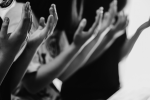May 7, 2020
Notre Dame and COVID-19
The Cathedral of Notre Dame de Paris has always held a special place in my heart. I’ve been fortunate enough to visit her more than 20 times, beginning when I was 17 years old. I’ve been there for prayer, for Mass, for quiet reflection from the park behind the Cathedral or the plaza in front of it. My sister and I took my dad there for his 90[1] birthday, where he was in awe of the fact that he was worshipping in the same place where Christians had worshipped for 850 years.
After the visit with our dad, I reflected on how much the Cathedral had given to me. I felt compelled to give back, beyond what I put in the offering plate when I visited. I checked out the Cathedral’s website, and I was shocked to discover how much work needed to be done to restore the structure. Gargoyles were falling off the façade. There was a question as to the stability of some of the flying buttresses. The central flèche (spire) was in disrepair.
The pieces that had fallen were stacked at the base of the Cathedral’s east end for all to see, but to no avail. Try as they might, they could not raise the amount of money necessary to ensure that the Cathedral would survive for the long term. Then April the 15th happened. One year ago, Notre Dame’s fabled “forest” of wood, which comprised the support beams for the lead roof, caught fire to catastrophic effect. All of the beams burned, and tons of lead melted. The flèche collapsed in on itself, and in so doing, broke through the vaulted ceiling, leaving a huge hole in its wake.
I was devastated by the loss. The Cathedral has always been a living, breathing entity to me. How could it be anything else, with 850 years of being prayed in? That night, French President Macron promised to rebuild the Cathedral in five years. The next day, pledges of money started pouring in, now totaling some €1 billion.
What happened? Why did people see no real reason to contribute when the Cathedral needed repair, compared to when we came within 30 minutes of losing her for all time? Here’s my guess: human beings are great at rallying in times of disaster. Our survival instinct and the desire to be heroic and overcome great challenges is encoded in our DNA.
We don’t have the same response to preventative maintenance, or even to needed repairs. It just doesn’t trigger anything urgent in us. In a very strange way, the near-destruction of the Cathedral of Notre Dame is what ended up saving her.
How does this relate to COVID-19? This pandemic has laid bare the great challenges that confront our world. Income inequality, lack of a health care system or access to it, treating senior citizens as disposable, the for-profit prison system, the abuse of the earth, to name but a few, are in plain sight, just like the fallen pieces of the Cathedral. And just like the fire in Paris one year ago, this virus has focused our attention on how critical the situation is.
For the first time, I hear people saying “I don’t want to go back to the way it was.” There is a desire to create something new. A new way of being: at work, at home, at play, and at prayer. The Church can and should be an instrumental part of this new renaissance. We have the potential to lead the way. We could be the convener, bringing together non-profit, for-profit, and governmental organizations. We could take the lead as the People of God to make all things new. We could use this time of global pandemic to reimagine and re-create life on earth.
This is not an easy task. In fact, it’s not a task at all. It’s a calling that will last our lifetime. It is bigger than anyone of us or any group of us, and there are more questions than answers, so there is plenty of room for the Holy Spirit to work. Are we willing to answer the call? Raise this issue with your vestry members, your clergy, your congregations. If we each take one inspired action, we’ll be on our way.
Photo credit: Gonzalo Fuentes, REUTERS
- 1. th





